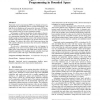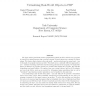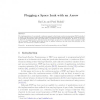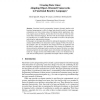POPL
2012
ACM
12 years 11 months ago
2012
ACM
Functional reactive programming (FRP) is an elegant and successful approach to programming reactive systems declaratively. The high levels of abstraction and expressivity that mak...
PLPV
2012
ACM
12 years 11 months ago
2012
ACM
Functional Reactive Programming (FRP) is a form of reactive programming whose model is pure functions over signals. FRP is often expressed in terms of arrows with loops, which is ...
PADL
2012
Springer
12 years 11 months ago
2012
Springer
We begin with a functional reactive programming (FRP) model in which every program is viewed as a signal function that converts a stream of input values into a stream of output va...
ENTCS
2007
14 years 3 months ago
2007
The implementation of conceptually continuous signals in functional reactive programming (FRP) is studied in detail. We show that recursive signals in standard implementations usi...
TLDI
2010
ACM
14 years 4 months ago
2010
ACM
Interactive programs, such as GUIs or spreadsheets, often maintain dependency information over dynamically-created networks of objects. That is, each imperative object tracks not ...
FLOPS
2006
Springer
14 years 7 months ago
2006
Springer
Functional reactive programming integrates dynamic dataflow with functional programming to offer an elegant and powerful model for expressing computations over time-varying values....
ESOP
2006
Springer
14 years 7 months ago
2006
Springer
This paper describes FrTime, an extension of Scheme designed for writing interactive applications. Inspired by functional reactive programming, the language embeds dynamic dataflow...
PLDI
2000
ACM
14 years 8 months ago
2000
ACM
Functional Reactive Programming, or FRP, is a general framework for programming hybrid systems in a high-level, declarative manner. The key ideas in FRP are its notions of behavio...
HASKELL
2009
ACM
14 years 10 months ago
2009
ACM
Functional reactive programming (FRP) has simple and powerful semantics, but has resisted efficient implementation. In particular, most past implementations have used demand-driv...
ICFP
2001
ACM
15 years 3 months ago
2001
ACM
Lula is a system for computer-assisted stage lighting design and control. Whereas other systems for the same purpose are usually the results of long chains of incremental improvem...





